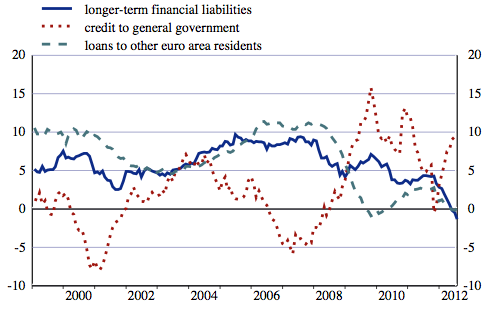Overnight Spain released its GDP data and as expected the news wasn’t great. The data showed that the Spanish economy shrunk by 1.3% in Q2 Year-on-Year. This was 0.3% larger than the initial estimate and came on top of this week’s revisions of lower growth in Q1. On a quarterly basis the contraction appears to be speeding up with a 0.4% fall in the June Quarter after a 0.3% fall in the march quarter.
I mentioned here and here that there is worse ahead for the Spanish economy as the next tranche of government cuts and tax hikes begins and the GDP numbers showed that both consumers and businesses continue to lower their economic activity in response. Consumer spending fell by 1% and fixed capital formation fell by 3%.
Although the data was weaker than expected, the Spanish government still managed to have a very successful bond auction in anticipation of coming ECB action on September 6th. Spain sold €1.7bn of 3mth bonds at 0.946%, down from 2.434% and €1.93bn of 6mth bonds at 2.026%, down from 3.69%.
There was also some evidence that the Spanish banking system is destabilising further due to deposit outflows. In July deposits fell by 5% across the Spanish banking system suggesting money is being moved to “safer” destinations. The Spanish government has claimed there is nothing to be concerned about and that this was “seasonal” due to the Spanish holiday season. I personally find it hard to believe that with 24% unemployment Spaniards are rushing off to international destinations to holiday, and previous years figures from July don’t appear to show similarly large changes in deposits. Something to watch closely.
Other dour news the came from the Spanish regions:
Catalonia, which generates around a fifth of Spain’s economic output, will tap a state liquidity line for just over 5 billion euros ($6.26 billion), a spokesman for the north-eastern region’s government said Tuesday.
The facility will cover financing costs linked to plans to cut its public deficit to 1.5 percent of gross domestic product this year, as well as maturing debt costs, the spokesman said.
The region would not accept political conditions for the aid, he added.
Of Spain’s 17 regions, Valencia and Murcia have also said they would need to tap the fund.
The government said in July it was setting up a mechanism to help the regions repay their debts, using funds from the state lottery and bank loans. But the facility is still not up and running.
Until recently it was thought that the Spanish economy was shrinking more slowly and in fact the Italians were leading the race down. The latest revisions in GDP along with the PMI data suggest that both nations are contracting around the same rate and suffering from similar issues of lack of internal and external demand. As I have noted numerous times, under these circumstances additional cuts to the government sector are likely to be met with even greater reversal in economic activity and therefore debt to GDP is likely to get worse, not better.
Mariano Rajoy is still adamant that he will not be seeking any form of bailout until the ECB has clearly stated exactly what support mechanisms it will be providing under any such program. It is becoming increasingly apparent, however, that he has little choice but to take what he is given, but in terms of systemic support whatever Mr Draghi announces on September 6th is becoming increasingly more important by the day.
Italy also had its share of bad news overnight with continuing downgrades to it’s banking system in the light of poor growth which Fitch Ratings stated as -1.9% for 2012 and 0% for 2013. I personally think the 2013 figure is a too optimistic given the long term trend and recent events:
Fitch Ratings has downgraded the Long-term Issuer Default Ratings (IDR) of Banca Popolare di Sondrio (BPSondrio) and Banco di Desio e della Brianza (BDB) to ‘BBB+’ from ‘A-‘, and the Long-term IDR of Banca Popolare di Milano (BPMilano) to ‘BBB-‘ from ‘BBB’.
The agency has also downgraded the Long-term IDRs of Banca Carige, Banca Popolare di Vicenza (BPVicenza), Credito Valtellinese (CreVal) and Veneto Banca to ‘BB+’ from ‘BBB’.
Simultaneously, Fitch has affirmed the Long-term IDRs of Banca Popolare dell’Emilia Romagna (BPER) at ‘BBB’ and of Credito Emiliano (Credem) at ‘BBB+’.
The Outlooks on all the banks’ Long-term IDRs is Negative.
Overnight we also saw the release of the July eurozone monetary aggregates. There was a surprise uptick in M3 which came in at 3.8% annual growth in July up from 3.2% in June. As usual, however, the breakdown of the data was fairly disappointing with annual credit growth private sector lower at -0.6%, consumer credit lower at -2.0%, loans to households steady at 0.3% and loans for home purchases steady at 0.8% growth. The upside of the data was that overall loans to the private sector actually grew by 0.1%, but as you can see from the chart below that rate is still recessionary. Full report is here:
DFM mentioned in his morning piece that Mario Draghi has cancelled his appearance at Jackson hole in order to concentrate on the eurozone and the upcoming September 6th ECB meeting where he is excpected to announce exactly what the ECB will be doing as part of his “believe me it will be enough” plan. As you can see from the data above he has to push against an increasingly strong economic headwind.
